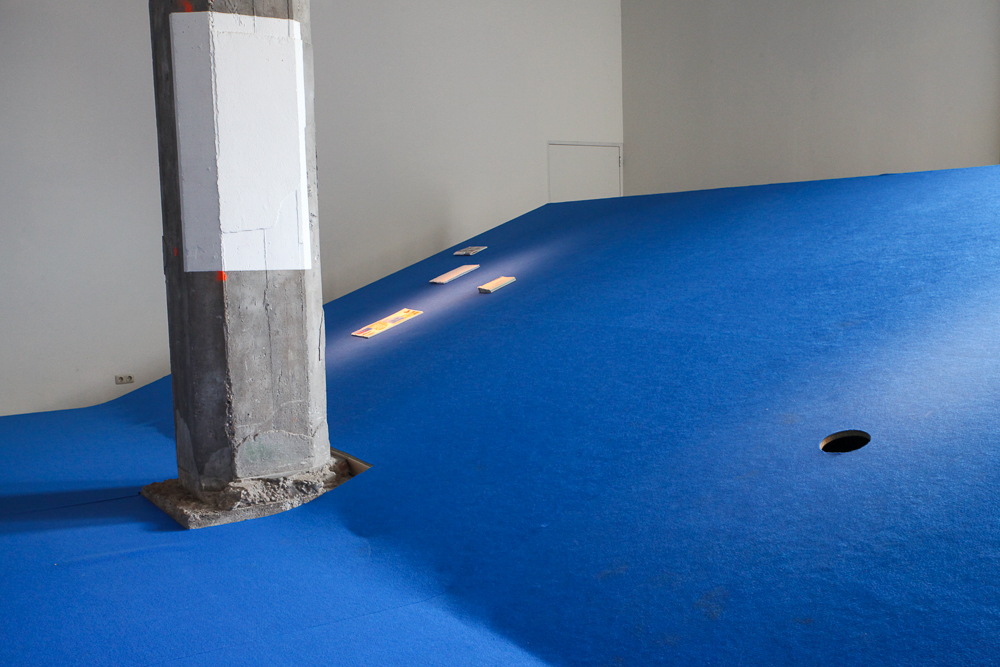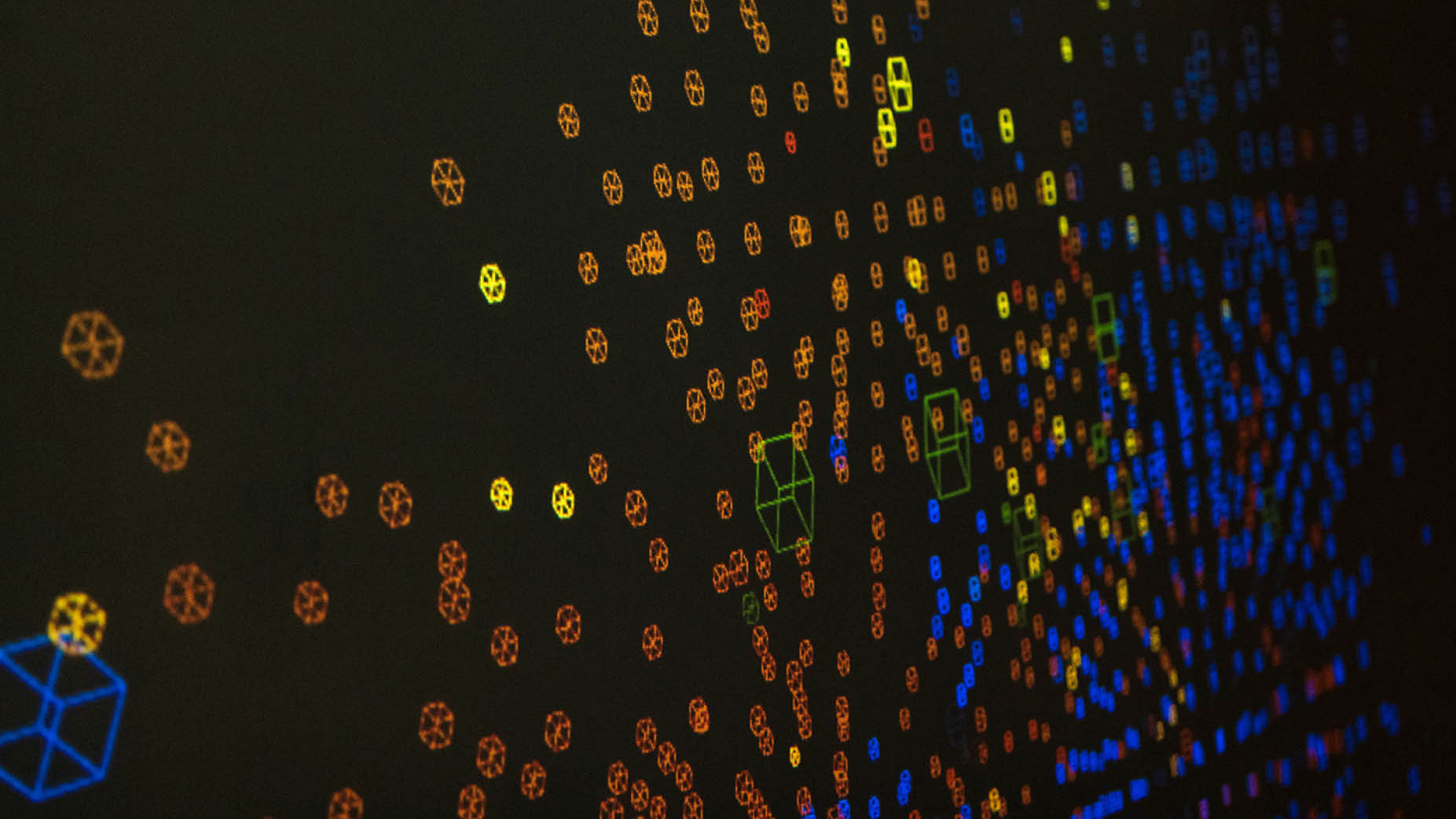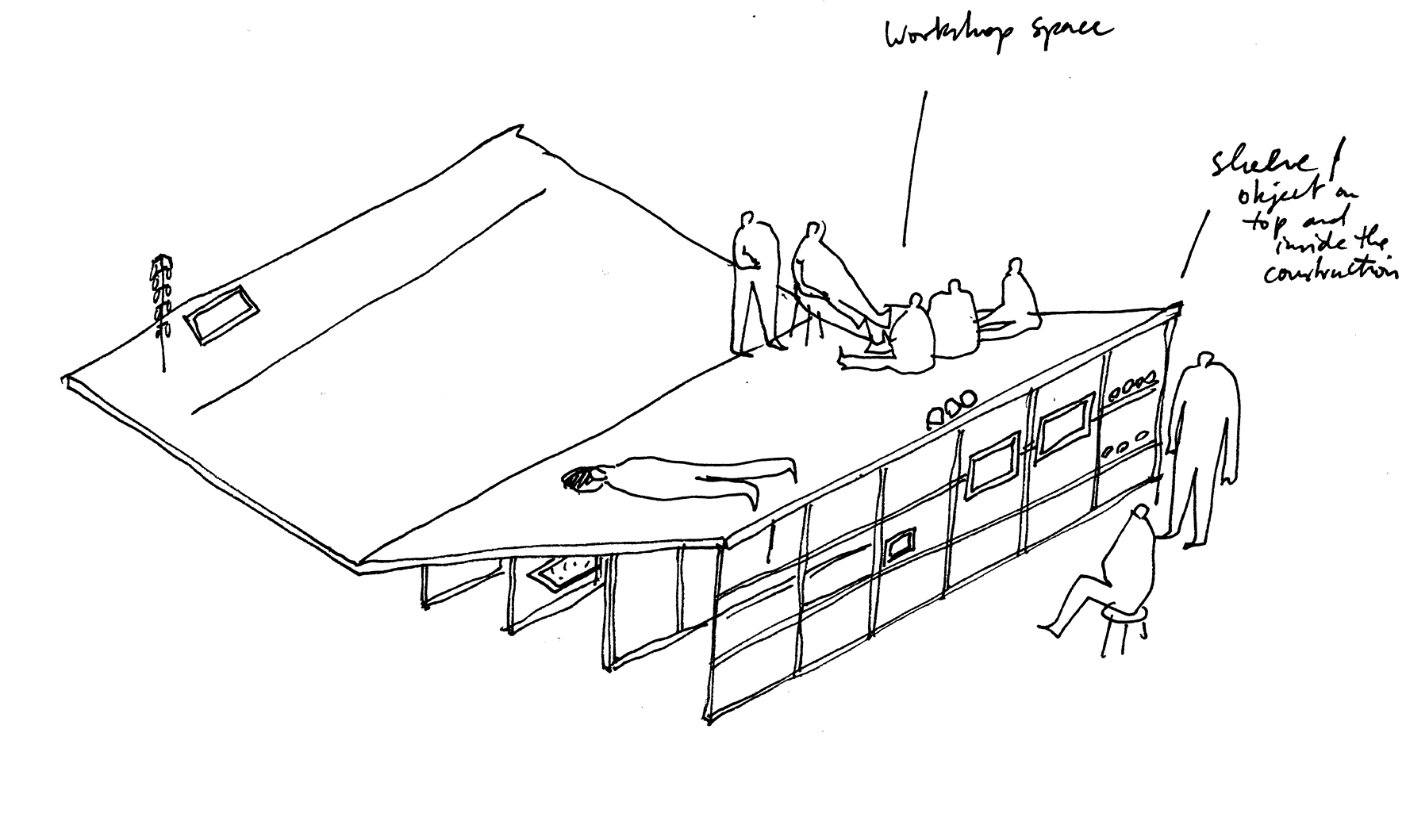
On a daily basis our bodies are being scanned, tracked, debugged, rendered, manipulated, and categorized by different technologies. How are we, as users and makers, able to understand our bodies' relationships to these biometric computational processes? Engaging with technologies such as scanners, geocomputation, and motion capture, BodyBuilding is a process-driven exhibition that problematizes the role of the 'body' in computation.
Curated by the Hackers & Designers collective (H&D), the exhibition investigates the intersection of technology and the agency of the (human, post-human, trans-human, non-human) body from a maker's perspective.
Together with scenographer and architect Thomas Rustemeyer Hackers & Designers reflected on the collective's platform function. The 'platform' became a support structure, which could serve as a stage, but also a ramp, a shelter and has been thought of as a space that can be used rather than looked at.The physical and interactive structure, through which visitors were able to move, view, experience, and interact with the different artworks was on view only for a short duration due to the outbreak of COVID-19.
To preserve and contextualize the collaboration with the different artists and tool makers we present here some insights, snippets, making of's, how-to's—drawing connections between these works. The exhibition's transition to the browser, structures and connects the works in different ways.
Feel guided by the hyperlinks or drift freely.
Find ON the platform Kiki Mager's work on "gait recognition" technology. 'Collective Gait' is an interactive, process oriented work, which uses the application of gait recognition as a starting point to unfold the complexity behind human motion capture technologies.
IN the platform you can find Nazanin Karimi's work 'Sunburned Land', which greatly influenced the angle of the platform. The work is a fictive portrayal of an actual location and its occurring events—focussing specifically on the ‘physicality’ of the landscape and its effects on narrative and the body of the audience.
UNDER the platform you will find the work by the collective The Underground Division (Helen Pritchard, Femke Snelting, and Jara Rocha). Their work ROCK REPO is a repository of digital and physical artifices questioning inhuman materialities and how they matter [in] the world and the crushing exploitations and extractions of normative 3D processes of geocomputation.
On and around the platform you will find the ephemeral, temporal practice of H&D, drawing together resources that informed the different works. Different local networks functioned as a resource library in the exhibition. Visitors could access the resources and research that went into each of the works by logging into the specific hotspots. The resource library here is translated into a list of resources underneath each work, consisting of images, videos, and textual materials that contextualize, expand, and intersect with the works on display.
The Underground Division is a collective research project on technologies of subsurface rendering and its imaginations/fantasies/promises. It is dug by Helen Pritchard, Jara Rocha, Femke Snelting with the help of many other others.
As a follow-up on Possible Bodies' research on co-construction of so-called bodies and 3D paradigms, the-body-of-the-earth is now attended as the framework for a study on similar sensibilities but different spacetimes. The Underground Division bugs contemporary regimes of volumetrics that are applied to extractivist, computationalist and geologic damages. The research will eventually culminate in the Trans*Feminist Rendering Program, a hands-on situation for device making, tool problematizing and "holing in gauge".
The ROCK REPO is a device built by a team of trans*feminist post-normal scientists for thinking with rocks. Managing rock slope instabilities by LiDAR, optimising strata modelling for fracking, rendering cavities in 3D for gaming, and algorithmically smoothed rock shaders are all deposited in the REPO. The REPO inquires into these banal, exquisite, kitsch, static, carbonivourous figurations to fracture the normative 3D processes of geocomputation and their crushing exploitations and extractions. Through making a collection of ROCKS, The Underground Division gets close to particular ROCKS and their unstable stories, as told through scientific and technological practice. Recognising that rocks have their own lively forces, the unruly team studies rocks’ 3D imaginings, the softwares and hardwares that rocks intervene on and builds new glossaries on the go. Their studies operate as a chipping away at what limits the resistant and destructive capacities of rocks.
The ROCK REPO device crosscuts with rocks as 'bodies' in a purposeful move away from the somatic corporealities of individual humans. This shift allows the team to ask about inhuman materialities and how they matter [in] the world. The REPO is an inquiry into what ROCK is, what it could be and the ways in which ROCK is seen or considered as an entity separate from its environment. It works with the 'deep implicancies'* of this moving between figure and ground, asking what happens as result of this cut, and what other formations could appear. Sharpened by queer and anticolonial sensibilities, it investigates the way ROCKS are quarried, measured, quantified, historicized, visualized, predicted, classified, modelled. The REPO, as an instrument itself, crystallizes other stories of spatial and temporal geologic processes and throws rocks through the glaciated windows of turbocapitalism.
* A term Denise Ferreira da Silva and Arjuna Neuman borrow from forensic genetics to talk about implications and entanglement in a non-linear way
Located close to the shores of a politically strategic territory, and placed in the middle of digital warfare, this island carries aggressive and charged news about drones, tankers, oil, weaponry, rivalry, deceptive claims, and false flag operations. The Sunburned Land is a fictive portrayal of an actual location and its occurring events.
In this new work, Nazanin focuses specifically on the ‘physicality’ of the landscape and the effects of the landscape on narrative and the body of the audience. The warmth, colors, and ambiguous topography are the natural elements of the landscape’s physical presence. Lying down and looking at a holistic picture on a tilted angle engages the body and mind in an experience that brings us closer to feeling the contrasting tranquility of the island. (The tilted surface, at -6° to -24°, stimulates blood circulation to give a neutralising and numb-like feeling while looking at the screen). Together, the flying movement of the camera, the physical weightlessness and numbness, and the storyline, create a bodily experience of a digitally narrated story.
The work began when Nazanin was developing a script for a new game environment and travelled to Iran to film and scan the landscapes there. While she was filming, new concerns were raised about the Hormoz Strait and its role in escalating political tensions between Iran and the West. The perception of potential violence was being shaped through the news, in digital media, and tweet wars. However, the ‘physicality’ of the location remained mostly unknown to the audience. Therefore, Nazanin travelled to the politically strategic Qeshm and Hormoz islands and tried to capture the natural landscape by filming and photographing it with a drone.
In order to play with the tension between fiction and reality, Nazanin combines 3D scanning, 3D modeling, and real footage to recreate the island. This way of working is the result of prohibitions that are in place at the Qeshm and Hormoz islands to freely fly a drone and use laser scanners for aerial documentation. By simulating the hidden characteristics of this geographic location, the work engages the audience in a critical exploration of the political reality of the Hormoz Strait. It allows us to move within the slippery space between fiction and non-fiction—questioning our trust in perceptions that are shaped in the absence of bodily experiences.
Process:
Media coverage:
Scientists have claimed that ‘gait recognition’ can determine an individual body based on its movement with 94% accuracy. While the use of gait recognition technologies for surveillance is an extreme example, it opens up a conversation about how individual body movements are interpreted and used in various fields. ‘Collective Gait’ is an interactive, process oriented work, which uses the application of gait recognition as a starting point to unfold the complexity behind human motion capture technologies.
The work creates a framework for a motion sculpture built from a continuously growing archive of motion signatures (gait / walk patterns), which are composed of points that each represent a sensor on the wearer’s body. The walking patterns are visually overlaid into one collective body walking through space. The motion sculpture gains volume through the combined differences between each pattern—taking the form of a mesh of bodies, their tracked bodily movements becoming a singular form.
This visualized collective gait sculpture is a reflection on scientific studies into individual gait patterns (movement signatures) and their application for surveillance purposes. Gait recognition operates in a similar fashion to facial recognition technology, with the shared claims of identity recognition, including personality recognition (mood, age, health, etc.).
The interaction with the tool acts as an experiential entry point for visitors into questions, frictions, opportunities, and consequences in relation to how technology is constructed to perceive human subjectivity at the level of bodily movements and how it de facto achieves to do so (or not). By generating a collective body of gaits, the tool asks: When is the individual gait abstracted so far from its recognizable pattern that gait recognition technology cannot be applied anymore?
Process:
Research:
Please note that these studies and scientific analysis need to be read through a critical lens.
In his work, Thomas Rustemeyer deals with forms of representation and their political and social implications, with a focus on spatial and urban issues. His works span different disciplines and media ranging from exhibition, scenography, publication, and drawing. For BodyBuilding, Hackers & Designers invited Thomas to collaborate on making a translation of the work of H&D into a spatial design.
As a reflection on the work of H&D, Thomas designed a platform that visually manifests the often invisible aspects of collaborative practice, such as maintenance work, as well as the manifold of encounters and interactions necessary for the network to come into being and sustain itself. The platform serves as a support structure for the invited artists, and the different hands-on activities that could be hosted and activated inside the exhibition. At the same time, the structure functions as a work in and of itself, translating the methods and approaches of H&D into a spatial arrangement.
The work takes the form of a physical and interactive structure, through which visitors can move, view, experience, and interact with the different art works. The structure simultaneously brings together and differentiates between collective and individual forms of engagement—accommodating collective workshop situations as well as the viewing of an individual video work. While highlighting the connections between the different artworks, the work mimics, in a tongue-in-cheek way, the ‘platform qualities’ of H&D, and also creates a space for the different activities that will take place during the exhibition period.
The exhibition infrastructure emphasises the way that H&D works as a collective, with a focus on process, prototypes, transparency, and criticality, exercised through workshops and interactive activities.
Process & Research:
References:
Hackers & Designers (H&D) is an interdisciplinary collective ‘body’ that functions as a network, an infrastructure, a host, and a facilitator for makers who come from different disciplines (art, design, computer programming). By initiating a diverse range of encounters that involve hands-on making, H&D aims to create opportunities for makers to meet and collaborate. H&D also makes educational resources available to the public by documenting and publishing tools, technologies and processes that are used and produced during workshops.
BodyBuilding would have not been possible without the kind support of Tetem, Stimuleringsfonds Creatieve Industrie, and the H&D collective.
Thank you to: Coordination and communication: Ella Buzo Production (build-up and build-down support): Daniel Maalman, Tygo Joosten (intern), Marieke Huizenga (intern), Esmee van Zeeventer (intern), Jan Dijkstra, Wietse Offringa, Daniel Maalman, Miguel Dominguez Platform construction: Sebastian Gräve Exhibition photography: Philip Ullman Technical consultation: Erik Overmeire Printing: Sander (Stencilzolder) Contributing artists: Nazanin Karimi Kiki Mager The Underground Division: Jara Rocha, Helen Pritchard, Femke Snelting Thomas Rustemeyer Special thanks to: ArtEZ and Martijn van Boven for loaning us screens Heerko van der Kooij, Selby Gildemacher, Juliette Lizotte and André Fincato Curation, production: Margarita Osipian Anja Groten
